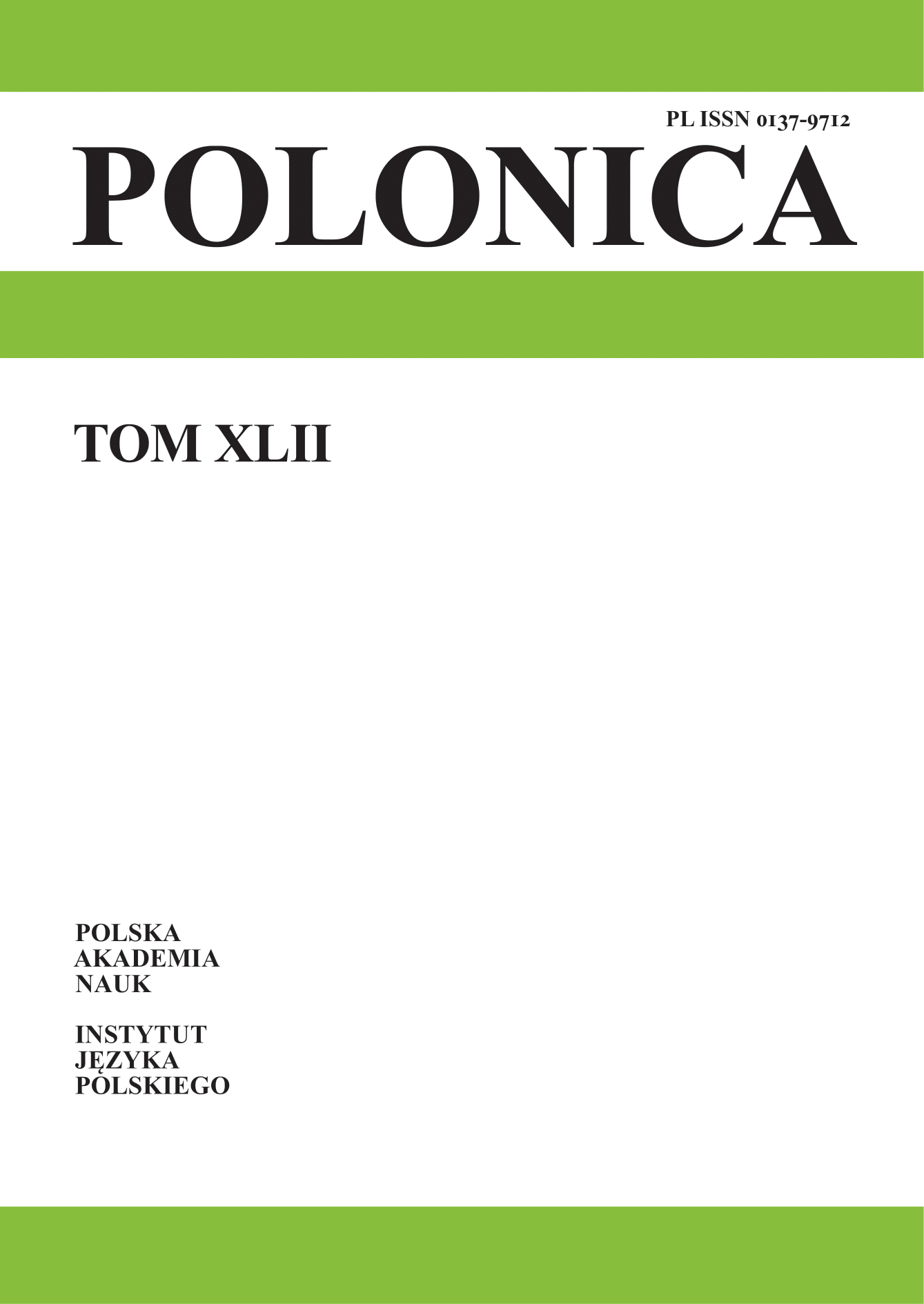Abstract
This article discusses the terms used in medieval text sources to denote the Hussites. It pays particular attention to the nominal phrase Bohemi heretici arguing that its lexeme constituents functioned in fifteenth-century Latin as synonyms. A more detailed examination focuses on types of synonymy established between two mentioned lexemes. The terms contextual synonymy and partial synonymy are used here. In addition, the importance of connotative meaning is pointed out as a criterion for analysing the usage of lexemes referring to Bohemia and the Bohemian people in the context of the Hussite heresy. The study is based on letters written by Polish secular and ecclesiastical chanceries as well as those written to Polish sovereigns and dignitaries by their foreign correspondents. In addition, the “Annals” of Jan Długosz are taken into account.
References
Adams, J.N. (1983). Words for ‘prostitute’ in Latin. Rheinisches Museum für Philologie, 126, 321−358.
Apresjan, Ju. D. (1995). Semantyka leksykalna. Synonimiczne środki języka. Tłum. Z. Kozłowska, A. Markowski. Wrocław–Warszawa–Kraków: Zakład Narodowy im. Ossolińskich.
Burstein, J., & Pedersen, T. (2010). Towards Improving Synonym Options in a Text Modification Application. University of Minnesota Supercomputing Institute Research Report UMSI-2010/165, 20.
Bylina, S. (2013). Image of a Heretic in Late Medieval Poland. Odrodzenie i Reformacja w Polsce, 57, 5−27. http://dx.doi.org/10.12775/OiRwP.SI.2013.01 First published as: Wizerunek heretyka w Polsce późnośredniowiecznej. Odrodzenie i Reformacja w Polsce, 30 (1985), 5−24.
Cruse, D.A. (2002). Lexical Semantics. Cambridge: Cambridge University Press.
Fruyt, M. (1994). Typologie des cas de synonymie en latin. In C. Moussy (ed.), Les problèmes de la synonymie en latin (pp. 25−46). Paris: Presses de l’université Paris-Sorbonne.
Kocourek, R. (1968). Synonymy and Semantic Structure of Terminology. Travaux linguistique de Prague, 3, 131−141.
Kras, P. (1998). Husyci w piętnastowiecznej Polsce. Lublin: Towarzystwo Naukowe KUL.
Kras, P. (2018). The Imagined Communities of Heretics: Constructing the Identity of the Religious Enemy in the Late Middle Ages. In A. Pleszczyński et al. (Eds.), Imagined Communities: Constructing Collective Identities in Medieval Europe (pp. 364−387). Leiden: Brill.
Lyons, J. (1981). Language and Linguistics. Cambridge: Cambridge University Press.
Lyons, J. (1977). Semantics. Cambridge: Cambridge University Press.
Manukyan, N., & Nikoghosyan, H. (2016). On Some Issues of Synonymy . Օտար լեզուները բարձրագույն դպրոցում [Foreign languages in high school], 1−2(20), 26−30.
Moussy, C. (2010). Synonymie et antonymie en latin. Paris: L’Harmatann (Collection: Kubaba-Grammaire et linguistique).
Nodl, M. (2018). Corporative Interests Versus Nationalism: Prague University at the Turn of the 15th Century. In A. Pleszczyński et al. (Eds.), Imagined Communities: Constructing Collective Identities in Medieval Europe (pp. 335−363). Leiden: Brill.
Nodl, M. (2015). Národ sobě: Ryzí Čechové a moderní nacionalismus. In M. Nodl (Ed.) Středověk v nás (pp. 168–174), Praha: Argo.
Pinkster, H. (2015). The Oxford Latin Syntax (vol. 1). Oxford: Oxford University Press.
Soukup, P. (2017). The Waning of the “Wycliffites”: Giving Names to Hussite Heresy. In J.P. Hornbeck II, & M. von Dussen (Eds.), Europe after Wycliffe (pp. 196−226). New York: Fordham University Press.
Spevak, O. (2014). The Noun Phrase in Classical Latin Prose. Leiden, Boston: Brill.
Stachura, M. (2010). Wrogowie porządku rzymskiego Studium zjawiska agresji językowej w Kodeksie Teodozjusza, Nowelach Postteodozjańskich i konstytucjach. Kraków: Historia Iagellonica.
Šmahel, F. (2000). Idea národa v husitských Čechách. Praha: Argo.
Wilde de, M. (2018). Enemy of All Humanity. The Dehumanizing Effects of a Dangerous Concept. Netherlands Journal of Legal Philosophy, 2(47), 158−175.
Zeng, X. (2007). Semantic relations between contextual synonyms. Us-China Education Review, 4(9), 33−37.
Sources
AC II – Ulanowski, B. (Ed.). (1902). Acta capitulorum nec non iudiciorum ecclesiasticorum selecta. Acta iudiciorum ecclesiasticorum dioecesum Gneznensis et Poznaniensis (1403−1530) (vol. 2). Kraków: Akademia Umiejętności.
Cioł. Lib. – Caro, J. (Ed.). (1871). Liber cancellarie Stanislai Ciołek, ein Formelbuch der polnischen Königskanzlei aus der Zeit der Husitischen Bewegung (vol. 1−2). Wien: Karl Gerold‘s Sohn.
CodEp II – Lewicki, A. (Ed.). (1891). Codex Epistolaris saeculi decimi quinti, tomus II. Kraków: Akademia Umiejętności.
The Correspondence − Kras, P., Manikowska, H., Starzyński, M., & Zajchowska-Bołtromiuk, A. (Eds.). (2018). The Correspondence of John of Capistrano, Vol. 1: Letters related to Poland and Silesia (1451−1456). Warszawa–Lublin: Tadeusz Manteuffel Institute of History, Polish Academy of Sciences–Wydawnictwo KUL.
Dł. 2000 – Turkowska, D. (Ed.). (2000). Joannis Dlugossii Annales sue Cronicae incliti Regni Poloniae, liber undecimus 1413−1430. Warszawa: PWN.
Dł. 2001 – Pirożyńska, Cz. (Ed.). (2001). Joannis Dlugossii Annales sue Cronicae incliti Regni Poloniae, liber undecimus et liber duodecimus 1431−1444. Warszawa: PWN.
Dł. 2003 – Turkowska, D. (Ed.). (2003). Joannis Dlugossii Annales sue Cronicae incliti Regni Poloniae, liber duodecimus 1445−1461. Kraków: Polska Akademia Umiejętności–PWN.
Dł. 2005 – Turkowska, D. (Ed.). (2005). Joannis Dlugossii Annales sue Cronicae incliti Regni Poloniae, liber duodecimus 1462−1480. Kraków: Polska Akademia Umiejętności.
Mikołaj z Błonia (Nicolaus de Blonie) Sermones de tempore et de sanctis, sive Viridarius. Strassburg: Typ. Iordani i.e. Georg Husner; 23 VIII 1498, Jagiellonian Library at Kraków: BJ St. Dr. Inc. 2857.
Corpora
CDł − The Corpus of Works of Jan Długosz https://voces.scriptores.pl/#dashboard?corpname=dl
CDS − Cross Database Searchtool of Brepols Publisher http://apps.brepolis.net.ezproxy.muni.cz/BrepolisPortal/default.aspx
PatrL − Patrologia Latina https://voces.scriptores.pl/#dashboard?corpname=PL

